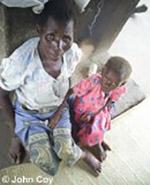Resource 1: HIV and AIDS in Africa
![]() Background information / subject knowledge for teacher
Background information / subject knowledge for teacher
http://www.avert.org/ [Tip: hold Ctrl and click a link to open it in a new tab. (Hide tip)] (Accessed 2008)
This is the web homepage of an organisation called AVERT, an international HIV and AIDS charity based in the UK, with the aim of AVERTing (preventing) HIV and AIDS worldwide.
You will find a good deal of useful information for teachers on this site.
HIV and AIDS useful facts and statistics for Sub-Saharan Africa
The AVERT site gives figures which your pupils may ask about. It also has a very useful guide to understanding the statistics.
Here is the summary of statistics for Africa. You will find more details for your own country on the website.
Sub-Saharan Africa is more heavily affected by HIV and AIDS than any other region of the world. An estimated 24.5 million people were living with HIV at the end of 2005 and approximately 2.7 million new infections occurred during that year. In just the past year the epidemic has claimed the lives of an estimated 2 million people in this region. More than 12 million children have been orphaned by AIDS.

The extent of the epidemic is only now becoming clear in many African countries, as increasing numbers of people with HIV are becoming ill. In the absence of massively expanded prevention, treatment and care efforts, it is expected that the AIDS death toll on the continent will continue to rise. This means that the epidemic's impact on these societies will be felt most strongly in the course of the next ten years and beyond. Its social and economic consequences are already widely felt, not only in the health sector but also in education, industry, agriculture, transport, human resources and the economy in general.
How are different countries in Africa affected?
HIV prevalence rates vary greatly between African countries. In Somalia and Senegal the prevalence is under 1% of the adult population, whereas in South Africa and Zambia around 15–20% of adults are infected.
In four southern African countries, the national adult HIV prevalence rate has risen higher than was thought possible and now exceeds 20%. These countries are Botswana (24.1%), Lesotho (23.2%), Swaziland (33.4%) and Zimbabwe (20.1%).
West Africa has been less affected by HIV, but the prevalence rates in some countries are creeping up. Prevalence is estimated to exceed 5% in Cameroon (5.4%), Côte d'Ivoire (7.1%) and Gabon (7.9%).
Until recently, the national prevalence rate has remained relatively low in Nigeria, the most populous country in Sub-Saharan Africa. The rate has grown slowly from below 2% in 1993 to 3.9% in 2005. But some states in Nigeria are already experiencing HIV infection rates as high as those now found in Cameroon. Already around 2.9 million Nigerians are estimated to be living with HIV.
Adapted from: http://www.avert.org/ subaadults.htm (Accessed 2008)
Kenya says HIV/AIDS rate drops to 5.9%
The Kenyan government said on Tuesday 26th June 2007 the rate of HIV/AIDS infections had dropped 5.9%, but the disease still posed a major challenge in the country.
The state-run National AIDS Control Council (NACC) said the rate fell from 6.1% in 2004 to the current 5.9% of the country's nearly 35 million people.
‘Of notable significance is the decline in new infections from 85,000 in 2004 to 60,000 in 2005 as well as the drop in HIV prevalence from 6.1% to 5.9% in the same period,’ said NACC chairperson Miriam Were.
Were emphasised that change of sexual habits and use of condoms had played a large part in slashing new infections.
The country aims to reduce the rate of infections to 5.5% by 2010.
Officials said awareness campaigns have succeeded in reducing Kenya's HIV/AIDS prevalence rate from 10% in the late 1990s, with condom use rising and a decline in the average number of sexual partners.
At least 1.3 million people are currently living with HIV/AIDS in Kenya, 65% of whom are women between the ages of 19 and 45, according to NACC statistics.
Last year, Kenyan President Mwai Kibaki announced that public hospitals would no longer charge HIV/AIDS patients for life-prolonging anti-retroviral drugs in a new bid to fight the deadly disease.
Since 1984, at least 1.5 million people are said to have died from AIDS in Kenya, according to health ministry estimates.
Adapted from: News 24, Website
3. Using role play and scenarios



